The River of Whispering Leaves
Listen closely. Can you hear it? It is the sound of a billion raindrops drumming on a ceiling of giant leaves, a constant, gentle percussion that has played for millions of years. The air you breathe is thick and warm, heavy with the scent of damp earth and flowers so bright they look like scattered jewels. A chorus of life echoes through my halls of green. The deep, guttural call of a howler monkey booms from the canopy, answered by the squawk of a scarlet macaw as it flashes through the branches. I am an endless ocean of green, a living, breathing world that stretches across an entire continent. At my core, a giant, winding river flows like a great artery, carrying my lifeblood to every corner of my vast body. I am ancient, I am powerful, and I am filled with more secrets than there are stars in the night sky. I am the Amazon Rainforest.
My story began 55 million years ago, during a time you call the Eocene epoch. The world was a very different place then. Great mountains, which you now know as the Andes, began to push their way toward the sky. This immense geological shift carved out the basin where I would be born, shaping the path of my great river. For millions of years, I grew in solitude, evolving into a complex web of life. Then, around 13,000 years ago, my first people arrived. They did not come to conquer me; they came to live with me. They were my children. They learned my rhythms, followed my seasons, and listened to my whispers. They discovered the healing powers of my plants and learned which fruits were sweet and which nuts were nourishing. They created astonishingly rich, dark soils called 'terra preta' by mixing charcoal, bone, and pottery into the earth, transforming patches of my floor into fertile gardens that helped both them and me to flourish for centuries. Their cultures and languages became woven into my very roots, a partnership built on respect and a deep understanding that we were part of the same living family.
For thousands of years, my children and I lived in this balance. Then, strangers appeared on my river. In the year 1541, a Spanish explorer named Francisco de Orellana drifted into my waters. He and his men were not looking for knowledge; they were hunting for legends, for cities of gold they called El Dorado. They spent over a year journeying the entire length of my main river, from the mountains to the sea. They found no gold, but they did find a world teeming with life beyond their wildest dreams. Orellana wrote of vast settlements and incredible encounters. During one skirmish, he was shocked to see fierce female warriors fighting alongside the men of a tribe. They reminded him of the legendary Amazons from ancient Greek myths, and so he gave my river his name: Rio de las Amazonas. Centuries passed, and new kinds of strangers arrived. In the early 1800s, Alexander von Humboldt came with notebooks and measuring tools, his mind filled with scientific curiosity. Later, between 1848 and 1852, Alfred Russel Wallace explored my depths, collecting thousands of specimens. He was not seeking treasure, but understanding. He watched my monkeys and butterflies, marveling at the subtle differences between them. His observations here were so profound that they helped him independently form his own theory of evolution, a world-changing idea.
My role extends far beyond my own borders. Scientists today often call me the 'Lungs of the Planet,' and for good reason. My trillions of trees are in a constant, silent conversation with the atmosphere. They breathe in the carbon dioxide that warms your world and breathe out the fresh oxygen that all living creatures need to survive. I am also a massive library of life, a living catalog of biodiversity. I am home to millions of species of plants, insects, fish, and animals, many of which are still completely unknown to science. This incredible variety is a treasure for humanity, holding potential cures for diseases and countless lessons about how life works. But like any ancient library, I am vulnerable. In recent history, parts of me have been hurt by fires and the cutting of my trees, a process called deforestation. This is a great challenge, but it is not the end of my story. Many dedicated people—scientists, governments, and ordinary citizens around the world—are working tirelessly to protect me, to heal my wounds, and to ensure my survival for generations to come.
My story is not over; it is unfolding at this very moment. My champions are the indigenous leaders who carry the ancient knowledge of my forests and fight to protect their ancestral homes. They are the scientists who study my delicate ecosystems and the young activists who raise their voices to demand a better future. And my story now includes you. The choices you make, the things you learn, and the care you show for the natural world all become a part of my journey. Protecting me is not just about saving trees and animals. It is about preserving a world of wonder, protecting a source of life for the entire planet, and safeguarding our shared home. My future, and in many ways, the future of your world, is in your hands.
Reading Comprehension Questions
Click to see answer
